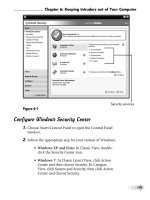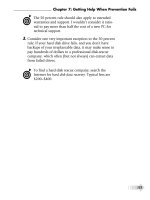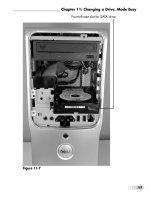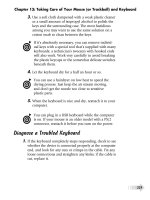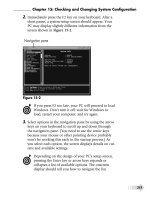Home robotics maker inspired projects for building your own robots
Bạn đang xem bản rút gọn của tài liệu. Xem và tải ngay bản đầy đủ của tài liệu tại đây (45.43 MB, 260 trang )
CONTENTS
INTRODUCTION
TOOLS GUIDE
COMPONENTS GUIDE
BASIC TECHNIQUES
01 BASIC BOTS
BRISTLE BOT
A battery-powered vibrating motor transforms an everyday nail brush into a crazy machine that will skitter energetically around on your
table top.
SQUIBBLE BOT
By attaching a couple of marker pens to an upturned drinks cup, we can make a bot that produces mind-blowing scribbles of its own
accord.
BUTTERFLY BOT
Building on the techniques we learned in Bristle Bot, two toothbrush heads are turned into a space-age butterfly that skips along on its
own.
ROBO ROACH
Robo Roach is equipped with insect-like feeler sensors that alert it when it encounters an obstacle and cause it to steer away from the
obstruction.
SPIRO BOT
This robot brings the Spirograph toy into the 21st century as we build a machine that creates psychedelic patterns of amazing variety.
02 SIMPLE ROBOTS
AVATAR
This project introduces you to computer programming using the JavaScript Blocks Editor to control the display on a BBC micro:bit
SCUTTLE BOT
Scuttle Bot transforms a metal tin into a machine that moves around under the control of a program on your mobile phone.
CATAPULT BOT
The Catapult Bot uses an infra-red motion sensor to activate the catapult’s firing mechanism when movement is detected.
GARDEN GUARDIAN
Robotics comes to your aid with this brilliant little machine that alerts your phone when a pot plant needs to be watered.
WALKING ROBOT
This robot tackles a considerable technical challenge – how to walk on two legs – and pulls it off with an ingenious solution.
03 SMART MAKES
ROBO WARRIOR
Fighting robots don’t have to be massively complicated to be effective in the combat zone – this lightweight warrior packs a mighty
punch.
CNC WRITER
This project introduces readers to the world of computer numerical control as we build a cool machine that can write messages on a pad.
MARS ROVER
NASA sent one to explore the surface of Mars, and here we learn how to construct an intelligent all-terrain rover vehicle along the same
lines.
RESOURCES
INDEX
INTRODUCTION
Building robots can at first seem like an impossible challenge, but really the only skill
that you must have is a passion for making things – everything else is just a matter of
learning and practice.
In this book I will show you how to build a number of different robots; some can walk, others can
draw and a few are inspired by machines that help humans every day. As you build these simple
machines, you will learn to put together electronic circuits, write pieces of software and use various
tools to assemble the bots. Who knows, once you have got a taste for it, you may develop into one of
our star robotics engineers?
01 BASIC BOTS
Every roboticist must start somewhere and there’s no better place than using what’s readily available
around the home. This first chapter features a series of simple mechanical robots that will hone your
basic skills. These projects include Bristle Bot, Squibble Bot and Butterfly Bot – a trio of vibration
robots that can skitter about. Robo Roach uses a readily available chassis that can be adapted to
create an autonomous touch-sensitive robot that finds its own way around, while Spiro Bot can create
amazing drawings on its own.
02 SIMPLE ROBOTS
Many robots use small electronic devices to imbue them with intelligence and precision control.
Programming can at first seem a little scary, but in reality it’s just thinking about the world in an
ordered, systematic way. To help you take your first steps into the world of software, I will teach you
a graphical programming language that is simple to learn.
Every piece of software also needs something to run on and
so I have selected the BBC micro:bit as our embedded
platform of choice. It’s extremely simple to upload new
programs to and has a lot of cool sensors built in. With
these simple programs and the micro:bit, we will build a
variety of intelligent machines including Walking Robot
and Scuttle Bot that can sense and interact with their
environment.
03 SMART MAKES
Once you have mastered the earlier projects, you will probably want to take on something a bit more
complicated. The three advanced robots in this book have been designed to give you the flexibility to
expand and modify them as you see fit. They do require a few more tools and parts than the other
robots, but don’t worry – there is a simple step-by-step guide to help you build them.
The first of them is a Robo Warrior designed for combat. Fighting with small robotic machines is
a popular competitive sport that is enjoyed around the world. There are a few important rules to
follow, but don’t worry – I will teach you all you need to know and show you how to build a simple
machine that can be easily adapted and customized. If you have access to a laser cutter, I have
designed a template to help you get started with your combat bot. If you don’t have access to one,
don’t worry – stiff cardboard works fine too. I have also created a file complete with a step-by-step
guide to help you configure your transmitter if you want to change the way the robot is steered. All the
files can be found and downloaded here: />
The second project, CNC Writer, is a type of CNC (Computer Numerical Control) machine. In
industry, robots are commonly used to perform repetitive tasks over and over again with high
precision. Finding the parts for a CNC machine might sound really expensive, but everyday objects
around the home actually use similar components. So for this project we will ‘go green’ and recycle
some old discarded electronics to build our own mini CNC Writer. This machine functions like and
understands the same language (GCode) as its larger counterparts. Like our other advanced projects, I
have prepared the software files for you, so you just need to build the physical machine. The files that
you will need to go with our step-by-step guide can be found here:
/>The real Mars Rover must rank as the ultimate remote-controlled robot. The final project in the
book shows how to build your very own machine that can roam about rough terrain. It is controlled
from your mobile phone. At its heart, this robot uses a board based on the popular Arduino platform –
this board can easily be expanded to accept additional sensors and there are also many popular
software libraries available to help add new functionality. Arduino commonly uses a text-based
programming language known as ‘C++’. This programming is too long and complex to be described
in this book, so to keep things easy and fun for you I have already done the hard part!
All the software that the robot needs can be found here:
/>
TOOLS GUIDE
Some basic tools and a few household items are all you need to start building your
own robots. Tools are also useful for doing any running repairs that might be needed.
Marker pen
Cross-head screwdriver
Flat-head screwdriver
Nut driver
Engineer pliers
Precision snips
Retractable knife
Multimeter
Glue gun
Crimping tool
Wire stripper
Safety glasses
Cordless drill
Drill bits
Drilling vice
Rotary multi-tool
Cut-off disc
Soldering iron and solder
Helping hands
Hex/Allen keys
Computer
COMPONENTS GUIDE
Every robot featured in the book has a specific list of required components, but here’s
an overview of some of the most important bits of kit that you will need to acquire.
AAA battery holder with wires
AA battery holder with wires
Switchable AA battery holder with wires
AA 4.5-volt battery holder with switch
AAA switched battery holder for BBC micro:bit
Modified battery box
Tamiya battery cable
4.8V NiMH battery
NiMH battery charger
20 AWG and 22 AWG stranded wire
Ring electrical crimp terminals
Terminal strip




